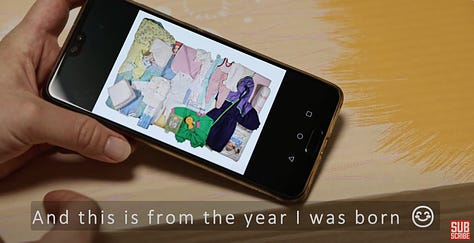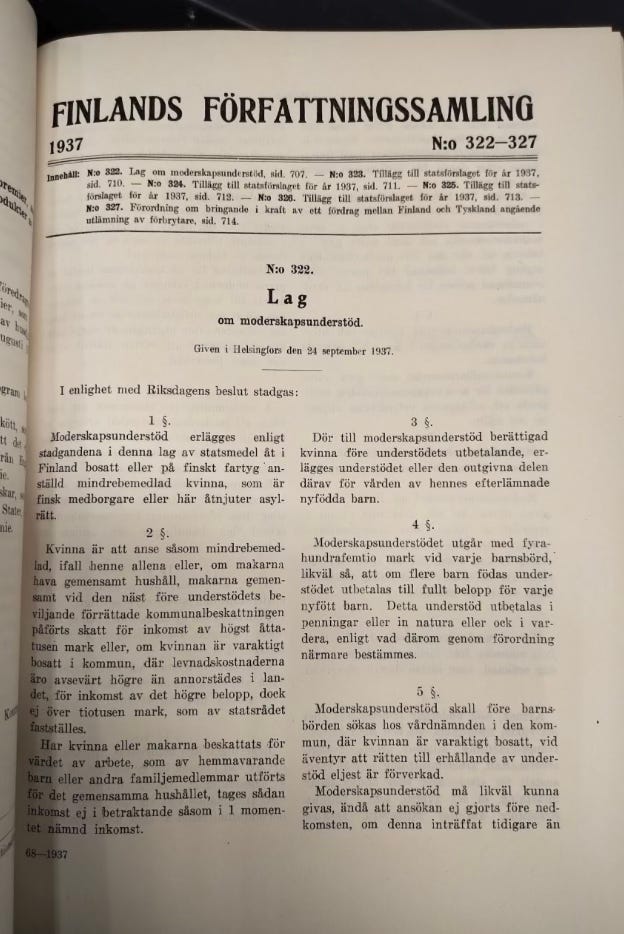Government services should be delightful!
You don't build an ethic of collective care by cutting corners
Let’s get the caveats out of the way as quickly as possible, so that we can spend the rest of our time admiring extremely fashionable, gender-neutral baby clothes.
This is an essay about a nice thing that a Nordic country does for its residents. In my experience, this variety of essay inspires extremely strong reactions! And I get it. It’s hard enough to live in a country whose welfare state is held together with duct tape, one which relies on the unpaid labor of individuals (especially women) to provide even a semblance of care and order. Of course headlines like “Norway To Provide Every Family With In Home Mediators For Sibling Disputes” or “Every Swedish Citizen Now Entitled To Either One Year Paid Sabbatical and/or Full Membership In Abba” inspire rage and consternation, especially in the United States. “Must be nice, Bjorn and Astrid,” we rage, from beneath a mountain of daycare waitlist notifications and hospital bills, “must be really freaking nice.”
If that weren’t enough, I’m also well aware of the counterpoints that get trotted out whenever it’s time for The Nordics Did Something Good discourse.
…but haven’t you heard that those countries are racist, and that they’re struggling in their transition to multi-ethnic pluralism? (Yes! A massive problem, one which very good folks in Scandinavia are working to tackle, but also not one that’s unique to those countries).
…and isn’t it also true that, in recent years, many aspects of the vaunted Nordic welfare states have been dismantled in the name of neoliberalism? (Yep, also true! And a huge bummer that should be resisted!).
…plus, isn’t it quixotic to point out that policies birthed in those countries could be applicable in places like the United States, Canada and the U.K., since the Nordics are tiny lands whose total populations could all fit onto one of the larger Ikea sectional sofas? (Not at all, as that’s not actually how economies of scale work, and also I believe the sofa in question is called a storplöåf).
…but Garrett, when are you and other writers going to finally hold Queen Elsa accountable for her dangerous tenure as ruler of Arendelle, including but not limited to her decision to freeze the entire kingdom in a fit of sisterly rage? (As an official spokesperson for the Queen, I would direct critics to her majesty’s official statement on the matter, namely that they should LETTT IT GOOOOOO!).
Listen, there’s a lot of potential for histrionics and overstatement here. But I do think it’s important, for those of us trying to build more loving, caring societies across the world, to occasionally take a deeper look at singular policies that could and should be replicated outside of their much vaunted and derided snow-packed countries of origin.
Is that OK? Great, because I want to talk about the baby boxes.
I assume you’ve already heard about the Finnish baby boxes. There was a moment, roughly five-to-ten years ago, when the western internet was ablaze with paeans to the large cardboard boxes that the Finnish social security agency (Kela) sends to its expectant mothers. You likely already know the basics: the Finns first instituted the äitiyspakkaus policy in the 1930s, in the midst of an infant mortality crisis. While initially only available to poor mothers, within a decade they expanded the program universally. The box itself doubles as a crib, but in addition to a mattress and bedding material, every äitiyspakkaus is filled to the brim with baby clothes (including outwear) in a variety of sizes, as well as health and family planning supplies for parents. To receive a box, Finnish mothers need to attend a series of prenatal check-ups, which of course are free under that nation’s universal health care system.
Again, you probably already knew all this. And if you’re an American mother, you’ve likely already thrown at least one laptop out the window in a fit of “why is my country so broken?” rage due to a previous baby box article.
But stick with me! I have a point. But to get there, I need to talk about this video.
This is Ihana Pon, a Burmese-Finnish mom. If you search “baby box unpacking” on Youtube, you’ll find scores of videos like this one, but hers is particularly engaging. Yes, my wife and I were filled with multiple moments of rage-jealousy when we watched it the other night, but it was impossible not to be charmed as Ihana pulled out each item, cooing with genuine appreciation. It wasn’t just the quantity that delighted her (although the boxes are filled with so much stuff, from hats and booties to a bathtub thermometer). It’s that, well, all of the items are super cute! And thoughtful! And distinct! The Finnish government didn’t just provide a set of necessities to its expectant families, they put clear care and attention into crafting an annual box that elicits pride and surprise.
It’s not just that parents get a bunch of onesies in their box, it’s that (in 2023 at least) they get onesies with adorable licorice and forest patterns…
…and a Moomintroll snowsuit/sleeping bag!
… and a duvet cover with a bunch of extremely happy whales on it!
You’ll notice that I specified that those are 2023 designs. That’s a key part of the cultural experience of äitiyspakkaus. Every year’s box is unique, which means that there is both fresh excitement in each unboxing experience (even for families with multiple children) as well as a built-in source of nostalgic pride for the specific boxes that you’ve received over the years. Here’s another Finnish mother, Raija, documenting her own life story through äitiyspakkaus snapshots.



“I still have that toy!” A toy she loves not because it was given to her by a beloved relative, but by her country’s social security administration! Imagine!
It’s no wonder why— even though Finnish parents have the option of forgoing a baby box and receiving a cash payment instead— that a majority of families from across all income brackets choose the äitiyspakkaus route.
In the last decade, there have been various attempts to replicate elements of the Finnish baby box in other spaces. The most comprehensive and successful has been in Scotland. Most efforts, though— be they small-scale pilots in U.S. cities focused solely on low-income families or private subscription services branded as “Finnish baby boxes”— miss the key point. It’s not just about a package full of stuff. The beauty of äitiyspakkaus lies in the bureaucrats at Kela lovingly curating a box of high quality items specifically designed to spark joy, connection and pride in being a member of a collective Finnish “we.” There’s a reason why the boxes also include a description of parental leaves and child allowance benefits, as well as that mandate of prenatal check-ups in government hospitals. The message is clear: äitiyspakkaus is neither an act of charity nor an individual consumer choice. The box is what binds Finns together.
You can see that message internalized in the videos. Raija leads with it, before she even starts showing off the items.
The same feeling is echoed by Ihana, an immigrant who is being introduced to the custom for the first time through her child’s box. Initially, she concludes her video in the manner of so many commercial “unboxing” reels— talking about which items were her favorites, which ones were left out, etc. But she soon realizes how that consumerist analysis misses the point and changes course. “This is a gift from the government!” she exclaims. “It shows how much the Finnish government cares about the families in Finland.”
Care isn’t cheap. Each box contains roughly 200 euros worth of clothing and supplies. The items in the baby box aren’t flimsy knock-offs, they’re all produced by Finland’s most popular children’s brands. And again, they’re provided to every Finnish family, regardless of income. The tradition would not be as revered if corners were cut, if Kela cared solely about care on a practical level rather than on an emotional and psychological level.
What’s so often missing in discussion about baby boxes is that they’re not just the product of a particular political ideology, but the willingness of a government—over the course of multiple decades— to ask a profound set of questions.
What makes a country more caring?
What makes parents, mothers especially, feel cared for by the government?
What makes parents, mothers especially, feel that they aren’t left alone in the act of caregiving?
But still. I can feel the laptops being hurled through the window again. “Great Raija,” some of you are likely saying, “you have so many pictures of tasteful baby outerwear on your phone… Do you know what I have? An eight-year-old who has to hang out with me during my afternoon waitressing shift because her school’s after care program was full!”
I’ve been thinking about baby boxes precisely because I live in a country that has chosen the siren call of laissez faire economics and White supremacy rather than collective care. And I worry that living in that society— even for those of us who dream of something better— has an erosive effect on our collective sociological imagination. We spend a lot of time, on the American left in particular, attempting to stave off disaster. We march against our nation’s military industrial complex. We shore up trans mutual aid funds and border state abortion clinics. We pump ourself up for another election cycle where the primary goal is avoiding the worst case scenario.
Granted, we sometimes ask proactively for something new— for Medicare For All, or Universal Healthcare, for reparations for Black and Indigenous Americans. But we rarely ask for our government to go all out in caring for us, to surprise and delight us, to offer mass transit that we can’t wait to board, a customer service experience at government agencies that is second to none, public schools in low income communities that look like true cathedrals of learning, and yes, a box full of baby clothes that makes us all coo “sooooo cute.”
We ought to demand delight from our government! Unreasonable levels of delight, in fact! And we should demand to be taxed— progressively, of course, in a way that asks much more of the wealthy and of corporations than the rest of us, but still— in order to receive those genuinely lovely public services. So too should we demand that our government wastes less money on expenditures that don’t delight anybody (bombs and guns, for one). And no, we shouldn’t give a damn at all about means testing, because once again the goal should be to make the kind of bespoke experiences that the wealthiest amongst us can already afford available to everybody, no questions asked.
Let us never accept anything less than a politics of shared delight.
Why?
Because ours is not a dour and funereal political movement. We love other people and want them to have a wonderful life.
So let’s act like it.
Let’s demand collective care in the best possible form: exorbitant, imaginative and overflowing!
Let’s welcome rampant government spending (as long as it directly increases collective thriving)!
Let’s happily chip in for anything and everything that would make our neighbors happier and less stressed!
Ours should not be a politics of martyrdom and flagellation. There’s enough nihilism and fear on the other side of the political spectrum. Let us continue to protest the wars and the bans and the assaults on democracy. But let’s also show up at the town halls and ask our congresspeople “why haven’t you ever sent me a box full of items that make me ooh and awww? Why isn’t our city’s central bus terminal the most beautiful edifice in the world? Why don’t our kids’ come home raving about their school lunch? Do you believe that your constituents are worthy of extravagant love?
Finland isn’t a perfect place. But it does many things well, including sending beautiful parcels full of baby clothes to expectant families. And it does so because of a law, a law that could just as well be passed anywhere, a law that isn’t magical or ephemeral.
Nothing is politically impossible if we imagine it, if we demand it, if we fight for it. And if there’s one thing I believe, it’s that if anything’s worth fighting for, it’s you all. All of you. All the time.
End notes:
For song of the week, I went with my favorite Finnish musicians. There’s nothing about the techno-industrial knob twiddling weirdos in Pan Sonic that screams “robust welfare state,” but isn’t it fun imagining the guys behind these bleets and blurts sleeping on top of a happy whale duvet cover?
I mean, while we’re on the subject, I guess I could have picked Finland’s legendary Eurovision winning pop metal monsters Lordi! Their mothers too once put them to bed in a government-issued cardboard box emblazoned with adorable cartoon animals. No wonder head monster Mr. Lordi paid it forward by serving as the posterchild for the government Covid vaccination campaign.
Also: I’m going to take (at least) one week off from inside baseball thoughts about which newsletter platform I use to send these emails (there’ll be an update there, I’m just not sure how soon). As always, know that your subscriptions matter a ton towards me being able to keep The White Pages up and running, but that there are multiple ways to become a subscriber— either directly through Substack, through a donation to the Barnraisers Project or by pre-ordering The Right Kind of White and then filling out this survey. Thanks!













Thank you for expressing so clearly what I have believed for years. Government services should be about caring, actually caring, about all of us. Every one of us should feel that they are an important part of our whole.
It's our money and our government that was formed to support us. But Americans have somehow been trained into thinking it's greedy and wrong to want our government to give us things that support the collective good. It takes my breath away - it hurts that much - that multiple Republican governors gleefully denied free food to children. They denied feeding kids over the summer. Hungry children. That's how far off the rails we've gone.